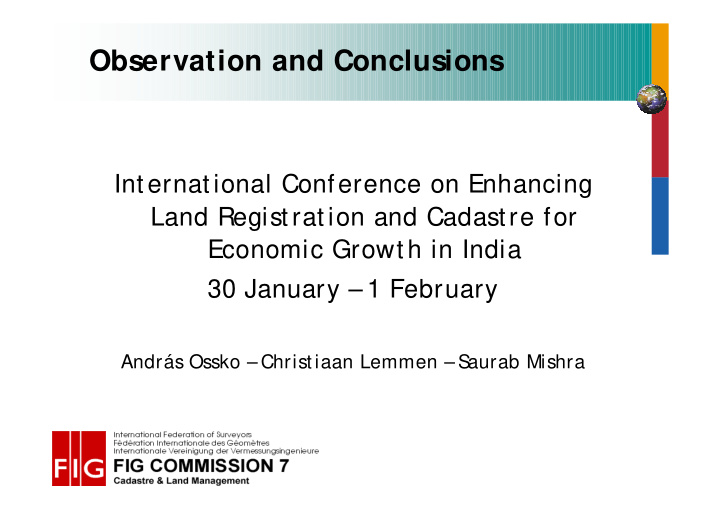



Observation and Conclusions Int ernational Conference on Enhancing Land Registration and Cadastre for Economic Growt h in India 30 January – 1 February András Ossko – Christ iaan Lemmen – S aurab Mishra
Taj Palace Hotel, Venue
McKinsey Global Institute Report 'The Growth Imperative' (2001)
World Bank § 'Land Policy for Growth and Poverty Reduction' (2003): investment in improving land records and land access § During a conference organised by the World Bank and the Ministry of Rural Development , the participant s agreed that improving land administration should be a top-priority for India
2 Day Conference § GIS Development , § Cent re for S cience, Development and Media S tudies (CS DMS ) and § FIG Commission 7 organised a conference on Enhancing Land Registration and Cadastre in India, as part of the bigger event MapIndia 2006
Statements by the speakers § maj ority of disput es in rural areas is land related, sometimes generat ions § chaotic situations for cadastral aut horities, they fail to act § urban areas: heavy pressure on land can be observed combined with a violation of land laws
Statements by the speakers § S low decision making; when decisions are made the population did already heavily increased § Establishment of proper land management § Maint enance of data is an issue; Resurveys which are scheduled are not happening in reality
Statements by the speakers § Not only private but also collective, use right s and women's access to land are relevant § The cost s of implement ing an online cadastre are estimated to be 2 US D billion § .. 1% loss in GDP comes to US D 73.8 billion per year
Statements by the Speakers § streamlining and simplification of land records maint enance process § e-conveyancing § use of GeoICT § procedures needed to be revised for digital scenarios § int egration between different depart ment s involved int o one environment
Pilot Project § Updating t o be int egrated with transactions § The system would operated by a dedicated, self-financing agency
Observations § Low t ransact ion cost s is a must , ot herwise people will not register § Cost recovery? There are cost reduct ions is ot her area’ s! What are t he cost s of a messy cadastre? (e- Gov) § Part icipatory approaches § Implement able syst ems based on user requirement s § Low cost surveying and mapping syst ems § LA is base for S DI § Dat a modeling & process design
Observations § Acquisition methods (orthophoto, satellite imagery, LIDAR, GPS , video) § Combined with existing methods § Quality labels
Conclusions § Innovations urgent , j oint effort, both from professionals and organisations § Willingness t o co-operate in favour of the citizens § First take care t hat the dat a are there: consistent , reliable, complete
Conlusions § Public land t o be surveyed & Registered § Establish an int egrated cadastral information society: facilit ate the change § Implement ation will take one generation… § Evaluate the legal meaning of digital data - eGovernment
Conclusions § Determination of illegal buildings is relevant , est ablishment of a proper basis for spatial planning too § Capacity building in (low cost) surveying and land registry § GNS S based survey has the fut ure § Develop PPPs, government has to be ready for that § Try to st andardize as much as possible
Conclusions § int egration of LA organizations, start with the database int egration and harmonisation § reference system upgrade § learn from good practise (Bhoomi) § separate court for trial of land disput es
Conclusions § the court is not a good environment for providing services, j udgement delays economic growth § economic growth for all – also the poor § this means LA for all, all people registered § revenues from proper LA are substantial: there is a solid basis for investments § start the developments
Final Remark § It is very easy to make it very complex, it is complex to keep it easy § The government is there for the people, not the other way around
Publication S lides and papers: § www.oicrf.org § www.fig.net
Recommend
More recommend